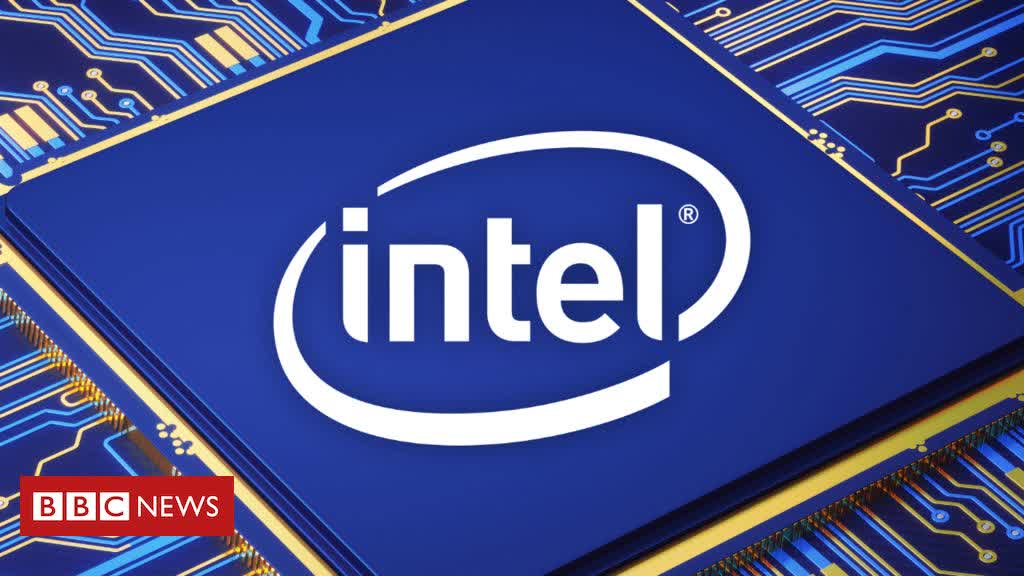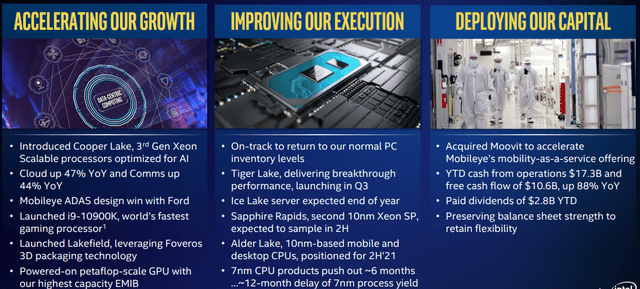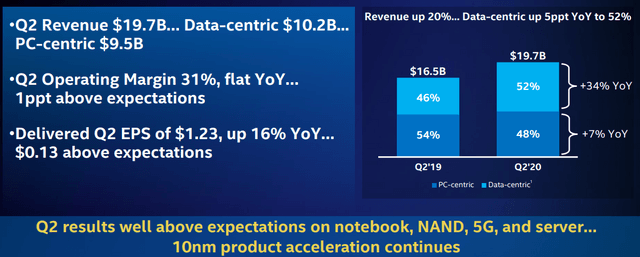Intel (NASDAQ: INTC) is a more than $230 billion technology company that has suffered since the start of the pandemic. As the company’s peers have recovered significantly, the company itself hasn’t performed nearly as well. Almost two months ago, we discussed how Intel should spin off Mobileye. While we maintain the thesis, Intel has chosen to sell its storage unit for $9 billion.
Intel Memory Business Sale
Original reports pointed to Intel selling its memory business for $10 billion. Instead, the reports have come out that the company has sold the unit for $9 billion. This seems to be a continuation of companies priced as “value traps” selling off assets in the current market, as another favorite pick of ours, AT&T (NYSE: T) continually does.
Intel was previously the 5th largest company in the NAND space. Other competitors, such as Micron (NYSE: MU), reacted profitably to the share price. The business generates respectable revenue and cash flow, $1.7 billion of revenue in the most recent quarter. The company posted a $300 million operating profit in 2Q 2020, a P/E ratio of ~8.
However, through 2019, it lost money. NAND is a commodity, and profits have varied significantly. The industry is becoming increasingly consolidated and at some point Intel had to choose to move up or move out. We would have liked to see the company make a move to acquire Micron a number of years ago, but it’s a bit late for that.
Regardless of the history of the business, the company has effectively generated $10 billion in cash. We’d like to see the company buy back shares, but it can do plenty else with the money.
Intel Overall Businesses
The remainder of Intel’s businesses have continued to trudge on.
Intel Overall Businesses – Intel Investor Presentation
Intel’s processors have struggled, which we’ll discuss in additional detail later. However, the company is working to catch up as it moves to its 7 nm process (5 nm for other companies). The company has introduced new scalable processors and cloud projects have continued to grow. The company continues to dominate the markets at the top end.
Advanced Micro Devices (NASDAQ: AMD) has significantly outperformed Intel from a market share change position. The company is working on solving its inventory issues and launching Tiger Lake. At the same time, the company is looking to launch its latest server processors. The company has seen a 6-month delay of 7 nm CPU products, which could hurt its long-term potential.
The company has continued to generate massive cash flow. The company acquired Moovit for $900 million to support Mobileye. The company’s YTD CFFO (half the year) was $17.3 billion, resulting in massive capital spending and $10.6 billion in FCF. That’s an annual market capitalization to FCF ratio of roughly 10.
The company has continued to pay its respectable dividend of near 2.5% and maintain its balance sheet. The company’s new $10 billion in cash will support the balance sheet.
Intel Processor Struggles
Intel’s overall businesses have continued to perform well, but the company continues to suffer from struggles with its processor business.
The company delayed its 10 nm products significantly and struggled to maintain sufficient volume. Now, once again, the news has come out that the company has been forced to push out its 7 nm products. Ideally, we’d like to see the company move to an alternative node source like Taiwan Semiconductor (NYSE: TSM).
Apple (NASDAQ: AAPL) is already launching a 5nm product (equivalent to Intel 7 nm). Intel should maintain and continue to work on its foundries but also work on volume backups. That can help the company protect itself. The struggles have resulted in the company losing ground to other companies. However, it’s already been more than priced in.
Intel Financial Strength
At the end of the day, Intel has focused on its incredible financial strength to support customers.
Intel Financial Strength – Intel Investor Presentation
The company has seen impressive performance from its data-centric businesses and saw 2Q 2020 revenue of $19.7 billion versus $16.5 billion a year ago. The company has maintained strong operating margins and delivered 2Q EPS of $1.23/share, up 16% YoY. That’s near $5 in annualized EPS a near single-digit P/E ratio.
The company has low total debt, just a few billion post the sale of the company’s memory group. The company has opportunistically purchased shares, although we’d like to see it do more of this given its current cash flow. Still, in the past year, it’s repurchased ~2% of its shares. At the same time, the company continues to invest heavily in its business.
The company’s financial and FCF strength are unparalleled and worth paying close attention to.
Intel Risk
Intel’s risk is through two major sources.
The first is that the company needs to continue investing massive amounts of capital to maintain its lead. The company has $13 billion in annual capital expenditures, and even then, it’s struggled with several major CPU runs. The company continues to have massive capital expenditures to achieve its positioning and even then it’s not guaranteed.
The second risk is that as hard as maintaining the company’s business lines are, the company’s competitors are even better funded. Apple has recently announced the multi-billion investment to move from Intel to ARM CPUs on its Mac line. Not only does the company need to maintain its positioning, it needs to compete in an even better funded tech world.
These are all worth paying close attention to.
Conclusion
Intel has an impressive portfolio of assets with a several hundred billion dollar market capitalization. The company recently announced a $9 billion sale of its memory business, raising immediate cash from a business that earned no money in 2019. Overall, the company has worked to improve its overall portfolio significantly.
Intel has the ability to continue generating significant future shareholder returns. The company has massive FCF to the tune of tens of billions annually. The company has recently undergone share buybacks, something that we recommend it continues going forward. The company has also continued to pay its dividends and reward shareholders.
As a result of these things, we recommend investing in Intel for the long run.
The Energy Forum can help you generate high-yield income from a portfolio of quality energy companies. Worldwide energy demand is growing and you can be a part of this exciting trend.
Also read about our newly launched “Income Portfolio”, a non sector specific income portfolio.

The Energy Forum provides:
- Managed model portfolios to generate high-yield returns.
- Deep-dive research reports about quality investment opportunities.
- Macroeconomic market overviews.
Disclosure: I am/we are long INTC, AAPL, AMD. I wrote this article myself, and it expresses my own opinions. I am not receiving compensation for it (other than from Seeking Alpha). I have no business relationship with any company whose stock is mentioned in this article.


